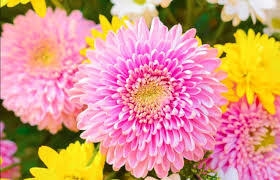Chrysanthemums, often referred to as “mums,” are some of the most beloved and versatile flowers in the gardening world. They are known for their vibrant colors, various shapes, and long-lasting blooms, making them a favorite for both gardens and floral arrangements. Whether you’re a seasoned gardener or just beginning, chrysanthemums offer beauty, symbolism, and ease of care. This guide will cover everything you need to know about chrysanthemums—from their history and symbolism to care tips and varieties.
1. History of Chrysanthemums
Being one of the most popular flowers around the globe, Chrysanthemums has its origin over three thousand years. Originally from Asia especially from China and Japan they were first grown and used as ornamental flowers in China around 1400B. C. In Chinese customs, flowers are associated with long life and are regarded as one of the “ Four noble plants”.
They originated from China and were transplanted to Europe during the 17th century and later transported to North America where they are grown for ornamental purposes and for use as cut flowers.
2. Symbolism of Chrysanthemums
In different cultures and with reference to the color, the flower symbolizes a number of things in different global societies. From a broader perspective, they represent happiness, optimism, and loyalty. However, specific colors have more nuanced meanings:
- White Chrysanthemums: ‘This purity; this innocence; this remembrance.’ The white chrysanthemums are being used in most of the Euro-predominating nations for funerals and any mourning occasion.
- Red Chrysanthemums: Affection emotions, strong feelings, likes and dislikes, attraction between male and female.
- Yellow Chrysanthemums: Happiness, gladness, and friendship; in some cultures, they are also signs of unrequited love or even grief.
- Purple Chrysanthemums: The three words that can be associated with the given concept are nobility, dignity, and admiration.
3. Species and Subspecies of the Chrysanthemum Plant
Today there are over 20000 chrysanthemum cultivars produced all over the world The chrysanthemum flowers can be of different sizes and colors and could be of various forms including dishes. They are divided into two main categories: Such as the garden mums and the florist mums.
Garden Mums: These are flowering plants that are perennial and can tolerate cold conditions of the region. It is often grown in gardens and utilized for beautifying a place for it is frost-hardy and grows fast.
Florist Mums: These are mostly more delicate and are more often than not utilized when arranging flowers that are cut. Florist mums differ from garden mums in the way they are grown since the former is normally cultivated in greenhouses and is not as cold-tolerant as the latter.
There are several popular chrysanthemum flower forms most of which are available at flower shops in Broken Arrow Oklahoma, including:
- Daisy-like: Smooth and relatively unfolded petals coming from a central disc, rather like any regular daisy easily available with Flower Delivery Tulsa OK.
- Pompons: Small flowers, round, compact-like spheres with small petals fused.
- Spiders: They have long and thin petals which are curled at the tips and look somewhat like spider legs.
- Anemones: A button-like structure of small petals located in the center and larger petal-like appendages located in the outer circle.
4. Chrysanthemums
Available at Best Florist in Tulsa Oklahoma are one of the most beautiful and popular flowers that you can get at Mrs. De havens and can also be grown in every garden, and it is necessary to learn how to take care of them, so that they will bring much joy to their owners. Here’s what you need to know to keep your mums healthy and blooming:
- Sunlight: Growing chrysanthemums need full sun exposure, which means this plant should be exposed to not less than 6 hours of sun rays per day. More sunlight promotes active flowering and growth hence more flowers and an enhanced disposition.
- Soil: A good example is chrysanthemum, which requires well-drained soil if it has to grow well. They are most comfortable with slightly acidic substrates, pH 6. 5- 6. 8, and with good organic content. It also involves good drainage because mums are prone to root rot.
- Watering: Water: Mums require frequent watering especially when they are growing vigorously during the growing season. They don’t like to sit in soggy soil though they are not too particular about the kind of soil they are planted in. It is recommended to water the plants at the base particularly not on the foliage in order to avoid the spread of fungal diseases.
- Winter Care: When it comes to garden mums they must be prepared for the winter. Prune the stems to a height of 10-15 cm and apply a mulch to the plant to cover the roots in frozen conditions after frost. In regions where the temperatures can drop to very low levels, mums have to be shifted indoors to survive the winter season.
Chrysanthemums are one of the most numerous, unpretentious, and elegant flowers which can be cultivated. From the flowering point of view, mums complement garden and floral needs with a large number of colors, shapes, and sizes. That is why today chrysanthemums are popular among flower growers due to their impressive history, references in culture, and; ease when it comes to care.
Read more Lifestyle Blogs Here.
